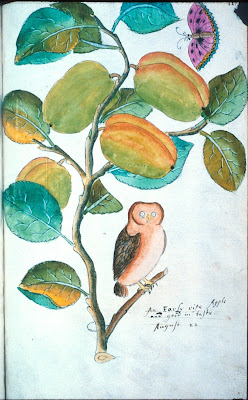
'The Red pescod plum'

'An Early ripe Apple and good in taste'

'The whighte peech'

'The yollow Nectrion'

'The Nuingetonn peeche'

'The portingegale Quince'

'The quene mother plum'

'The whight Date'

'The grete \Early/ yollow peech'

'The grete Roman Hasell Nut'

'The Imperyall plum'

'The May Cherry'

'The Mussule plum'

'The Apricooke (that is booth Long and greet)'

'The frier plum'**

'the great French stra(w)bere'

'The grene pescod plum'
John Tradescant (~1570-1632) and his son, also named John (1608-1662), were gardeners to the nobility and royalty of England and both travelled widely collecting botanical specimens. Between them they introduced a large number of foreign species (including many of the fruits depicted) that remain prevalent in the average English gardens of today.
Their exotic tendencies manifested themselves most influentially at the estate begun by John Snr in the borough of Lambeth on the Thames river, near London. In addition to the more than 700 species of plants growing in the garden and orchard, the house itself (known as Tradescant's Ark) was a veritable cabinet of curiosities, where John Snr and later, John Jnr, displayed the many novel items they each had collected during their foreign travels.
Tradescant's Ark is regarded as the first English museum and people were happy to pay an entrance fee to see not only the 'regular' inventory of coins, weapons, stuffed animals, peculiar foreign garments and the like, but were also treated with a glimpse of the more fanciful: a section of Christ's cross and the hand of a mermaid, among other things. In 1656, John Jnr published a catalogue called 'Musaeum Tradescantianum', which recorded in detail the contents of the house and garden.
It was probably around 1650 when John Jnr became acquaintanced with the antiquary, politician and alchemist, Elias Ashmole. Ashmole was intensely interested in the Ark's contents and probably agitated for its itemisation for the 1656 book that Ashmole himself funded.
From reading around online, I'm not completely convinced as to the true circumstances that followed, during John Jnr's later years. Certainly Ashmole had John Jnr sign a bequesting authority that would allow Ashmole to inherit the museum's contents upon the death of John Jnr's wife. There had been discussions about the collection going to a University. However, after John Jnr died , a court case with Hester Tradescant (wife) ensued in which Ashmole was awarded control of the collection and, either ironically or conveniently, Hester was found drowned at the Lambeth estate in 1682 by Ashmole's wife (Ashmole had moved in next door to Tradescant by this stage). The whole affair is coloured by intrigue, psychological shenanigans and, no doubt, a healthy slice of greed and ego.
Subsequently, the collection (including the fruit sketches) was donated to Oxford University, thereby establishing the now very famous Ashmolean Museum. It is said that Ashmole, at least initially, passed off the collection as his own. It is also said that Ashmole was an energetic curio collector himself, but it seems certain the vast majority of the gift to the university was from the Tradescant Ark. I wonder if a name change has ever been canvassed for the museum? The overall arguments range of course from Ashmole being a magnanimous cultural benefactor who ensured the lasting fame of the Tradescants to his being nothing more than a conniving vulture &c. Methinks I want to read the books. There is a LOT more of interest about the lives of these fascinating gardener-collectors that I've not even hinted at really.
The watercolour illustrations seen above were made by an unknown artist sometime between 1611 and 1630. It took me a little while before I decided I like them (and I do). At first blush it's easy to conclude something along the lines of 'naïve' or 'technically unsophisticated', but the vibrant colours and overall compositions are nonetheless attractive. It's one of those times where I made up my mind partly because the art (and seeming detractions) held my attention for long enough that that in itself signalled a certain a positive quality or impact, if that makes sense. Then I looked more closely and came around. John Tradescant Snr probably contributed to the album of 60+ sketches, at least in so far as they are arranged in an approximately dated order with respect to the time of fruit ripening (these dates are mostly written on the illustrations). Click on the images above for full size versions - they are cropped, but still full page images. I removed one library stamp but made no other adjustments.
- The Bodleian Library at the University of Oxford host the Tradescant Orchard illustrations. Thumbnail pages: one, two, three.
- The Tradescant exhibition site at the Ashmolean Museum.
- Vauxhall Society on the Tradescants.
- 'Repatriating the Ark' from Parabola Trust - the 450th anniversary last year of 'Musaeum Tradescantianum'.
- Antiquarian bookseller page re: 'Musaeum Tradescantianum'.
- Book One: 'Strange Blooms: The Curious Lives and Adventures of the John Tradescants' by Jennifer Potter, 2006 (Atlantic Books) - sounds to be a thorough examination of the small amount of primary evidence (and a lot more inference made from secondary sources such as accounts ledgers) about each of the Tradescants' lives. Reviews: one, two, three (there are more around).
- Book Two: 'The Tradescants: Their Plants, Gardens and Museum, 1570-1662' by Mea Allen, 1964 [link]. I didn't notice any commentary on this from a quick search.
- Book Three: 'The John Tradescants: gardeners to the Rose and Lily Queen' by Prudence Leith-Ross, 1998 [link]. Again, no idea about this one.
- Book Four: {This is an historical novel} 'Earthly Joys' by Philippa Gregory, 2005 [link] (there is more around on this).
- Wikipedia: 'Musaeum Tradescantianum'; John Snr; John Jnr; Elias Ashmole.
- ** Link to transcribed diary entry of a person's impression of the frier plum illustration when they saw it in the sixties.
- Previously: John Jnr collected some insects in Virginia for Alexander Marshal.




No comments:
Post a Comment